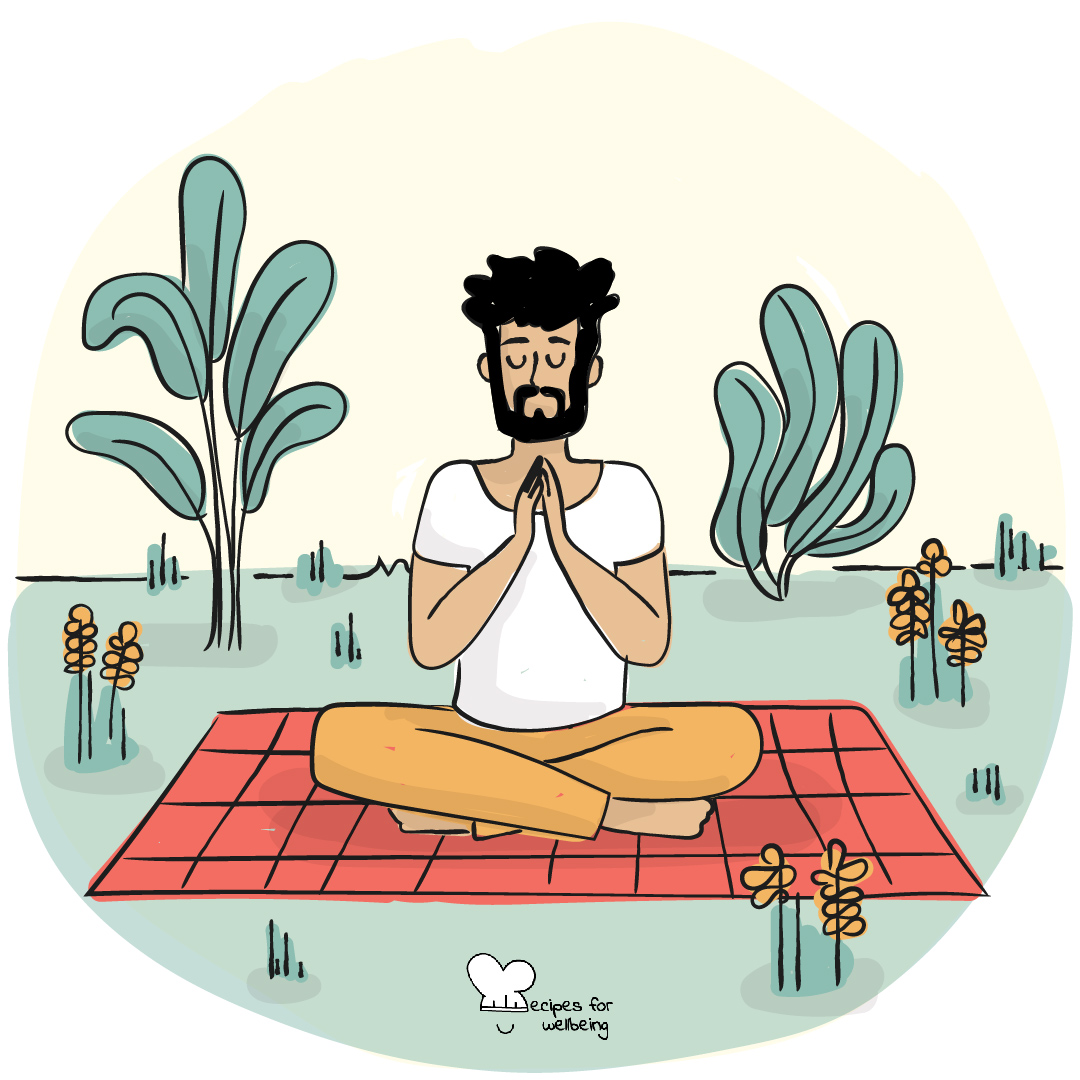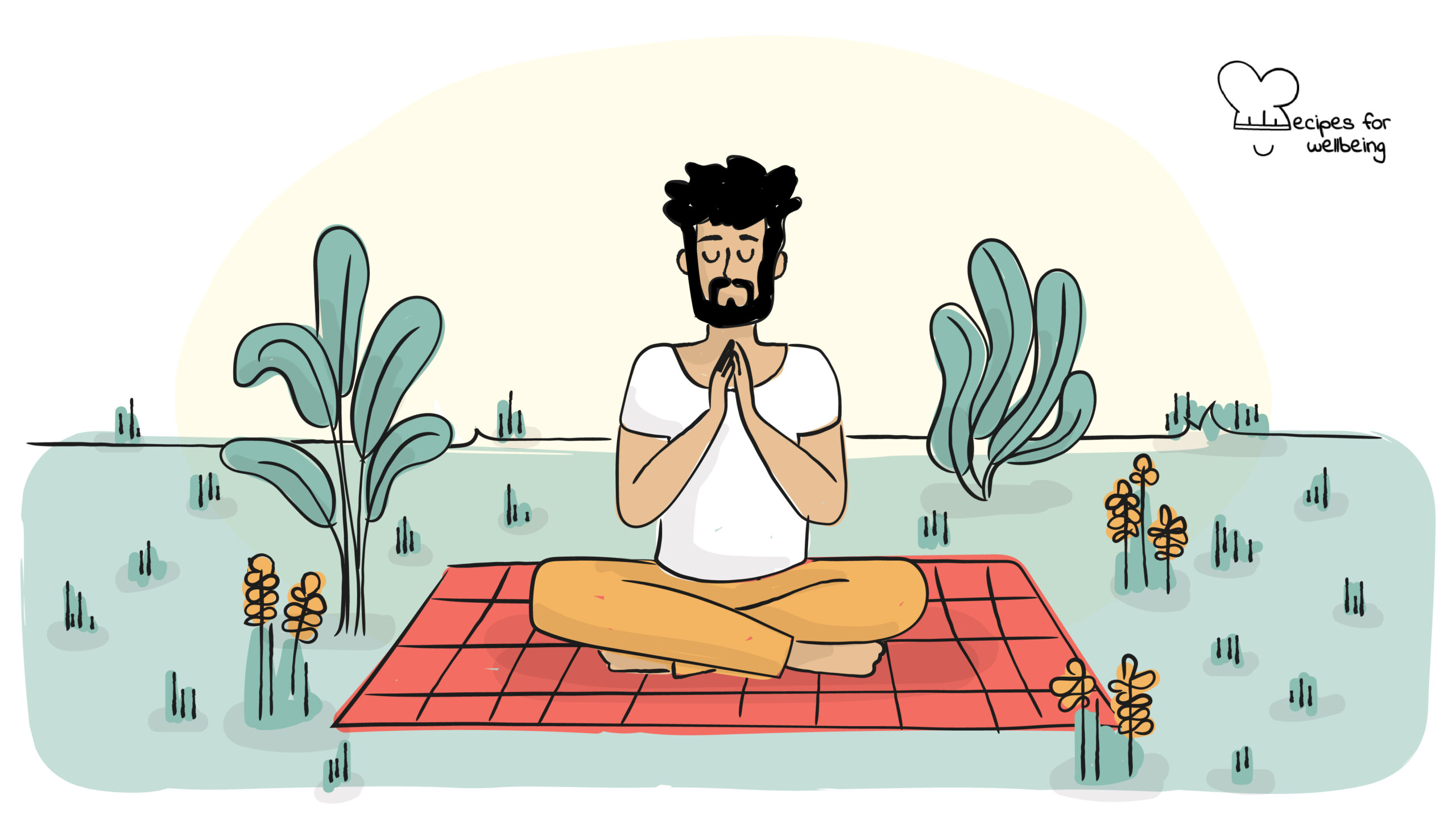
Body scan meditation
Through repeated practice of the body scan over time, we come to grasp the reality of our body as whole in the present moment. This feeling of wholeness can be experienced no matter what is wrong with your body. One part of your body, or many parts of your body, may be diseased or in pain or even missing, yet you can still cradle them in this experience of wholeness. ― Jon Kabat-Zinn
👥 Serves: 1 person
🎚 Difficulty: Medium
⏳ Total time: 11-30 minutes
🥣 Ingredients: A quiet place with no distractions, “Mindfulness: A practical guide to finding peace in a frantic world” book by Mark Williams and Danny Penman (if you’re curious to find out more about it!)
🤓 Wholebeing Domains: Awareness, Rest
💪 Wholebeing Skills: Balance, Mind-body-connection, Mindfulness, Relaxation, Self-awareness, Stillness

Body scan meditation
📝 Description
A brief meditation to re-align body and mind.
The following activity has been taken from Mark Williams and Danny Penman’s book Mindfulness: A practical guide to finding peace in a frantic world. The book guides you through an eight-week mindfulness-based programme to provide you with a set of powerful practices you can incorporate in your life to let go of anxiety, stress, and unhappiness. Mindfulness-based cognitive therapy (MBCT) helps you keep up with the demands of modern life and find joy in your work as a changemaker.
This body scan meditation is a simple exercise to help you re-integrate your mind and body into a harmonious whole. As changemakers, we spend too much time in our heads, brainstorming solutions to social and environmental challenges, and we often forget about the incredible wisdom our body has to offer. In fact, by tuning into our body, we learn a lot about how we are and whether we are pushing ourselves to the point of burnout.
Below you will find the written guidelines, but if you prefer, you can listen to an audio-version of the body scan meditation. Or if you’d like to try it out before going to bed, check out our recipe “Body scan meditation for sleep”.
To find out more about Mark and Danny’s work, please visit http://franticworld.com.
👣 Steps
Step 1 – Prepare (1’)
Lie down on your back and make yourself comfortable in a place where you will feel warm and undisturbed. You can lie on your bed, directly on the floor, or on a rug. Wrap yourself in a blanket if that feels comfortable. You may find it helpful to close your eyes, but do feel free to keep them open if you prefer, or to open them at any time during the meditation if you feel you are falling asleep.
Step 2 – Focus on physical sensations (1’)
Take a few minutes to bring your awareness to the physical sensations in your body, especially to those of touch or pressure where your body makes contact with whatever you are lying on. On each out-breath, allow yourself to sink a little deeper into the surface.
Step 3 – Fall awake (1’)
Gently remind yourself that this is a time for ‘falling awake’ rather than falling asleep. It is a time to be fully aware of your experience as it is, not as you think it should be. You should not try to change the way you are feeling, not even to be more relaxed or calmer. The intention of this practice is to bring awareness to any and all sensations as you focus your attention systematically on each part of your body. Sometimes, you may feel no sensations at all. If that is the case, then simply acknowledge this. There’s no need to try and imagine sensations where none can be noticed.
Step 4 – Focus on your abdomen (2’)
Now bring your awareness to the sensations in your abdomen, becoming aware of the changing patterns in the abdominal wall as the breath moves in and out of your body. Take a few minutes to feel the sensations as you breathe in and out, as your abdomen rises and falls.
Step 5 – Scan the body (3’)
Having connected with the sensations in your abdomen, gather your attention as if it were a spotlight, and bring it down the body into your legs, into both feet, and all the way out to your toes. Focus on each of the toes, bringing a gentle, interested attention to them. Investigate the qualities of the sensations. You might notice a feeling of contact between the toes, or perhaps feel a tingling sensation, or one of warmth, or numbness, or absolutely no sensation at all. Whatever you experience is okay. There is no need to judge it. See if it is possible to allow the sensations to be just as they are.
Step 6 – Breathe with your full body (2’)
On an in-breath, feel or imagine that the breath could enter the lungs and pass all the way down the body, through the legs and into the toes. On the out-breath, feel or imagine the breath flowing out of the toes, feet, legs, torso and, finally, out of the nose. Continue focusing in this way for a few breaths. You might find it difficult to get the hang of this, so just practise the best you can, approaching it playfully.
Step 7 – Focus on your feet (3’)
When you are ready, on an out-breath, let go of the toes and bring your awareness to the sensations in the bottom of your feet. Bring a gentle, investigative awareness to their soles. Then move your awareness to the instep and then the heel of each foot. You might notice, for example, a slight sense of pressure where the heels make contact with the mat or bed. Experiment with breathing into any of the sensations that you discover, being aware of the breath in the background as you explore the sensations in the bottom of the feet.
Allow your awareness to expand into the rest of the feet, into the top of the feet, into the ankles, right into the bones and joints. On a deeper and more intentional in-breath, direct it down into both feet. On the out-breath, let go of the feet completely and shift your attention to the lower legs.
Step 8 – Continue with the body scan (5’)
Continue scanning your whole body in the same way, linger for a time over each part in turn. After your lower legs, move up to the knees and then the thighs. Now move your awareness to the pelvic area – your groin, genitals, buttocks, and hips. Become conscious of your lower back, abdomen, upper back and, finally, your chest and shoulders. Gently bring your awareness to both hands. When you focus on your hands you could first attend to the sensations in the tips of your fingers and thumbs, then the whole finger and thumbs, the palms of the hands and then their backs. Then gently move to your wrists, lower arms and elbows, upper arms, shoulders and armpits. Then move your awareness to your neck, your face (jaw, mouth, lips, nose, cheeks, ears, eyes and forehead) before, finally, holding your entire head in full awareness.
You should hold each region of your body for, perhaps, twenty to thirty seconds. There is no need to measure the time accurately or count the breath – simply attend to each part of the body in turn for as long as seems natural.
When you become aware of any intense sensations, such as tension, in a particular part of your body, see how it is to ‘breathe into’ them to explore them further. Then see how the sensations change – if at all – when you breathe out of them.
From time to time, the mind will inevitably wander away from the breath and body. This is entirely normal. When you notice it, gently acknowledge the fact, make a mental note of where your thoughts went off to, and gently return your awareness to the part of the body you intended to focus on.
Step 9 – Become aware of the whole (2’)
After you have scanned the whole body in this way, spend a few minutes becoming aware of the body as a whole. Feel the sensations of wholeness. See if you can hold all of the fluxing sensations in spacious awareness, feeling the breath flowing freely in and out of the body.

